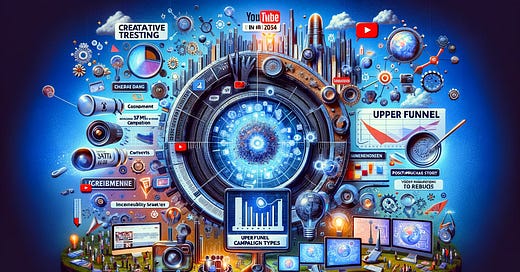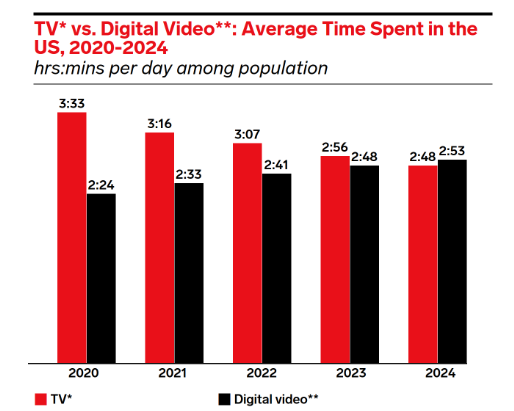This past week Andrew Foxwell hosted his YouTube Ads Mastery Summit.
I was unable to attend, but Mike (our stellar Google Ads manager at Eight Sleep) was in attendance and mentioned that he got a ton of value from the discussions.
As Mike and I chatted about the lessons from the summit and our learnings from the past year it got me thinking:
Is YouTube ads our next 10x growth channel?
In this post, I will share some of the notes that Mike took from the summit and how we plan to leverage YouTube in 2024.
Let’s dive in!
First, a quick primer on YouTube usage.
TLDR: YouTube is big with a ton of daily usage.This probably comes as no surprise to all of the hardcore marketers out there, but YouTube is big.
According to Statista, Youtube is the second largest social media platform with ~2.4 billion monthly users.

YouTube users also use the platform a lot.
Statista has data that shows that 62% of YouTube users access the platform daily:

The surprising thing is that YouTube still makes up a relatively low percentage of total DTC brand budget.
According to Northbeam’s Media Buyer Newsletter (sent 12/17/23), only about 3% of the total budgets from the brands on its platform are going to YouTube ads.
This makes me think that there is still a ton of opportunity left for brands to use YouTube as a massive growth lever in 2024.
Alright, let’s get it into some of the summit takeaways.
Key takeaways
Foxwell had some of the smartest YouTube marketers in the space as speakers for his summit this past week.
Mike shared his notes with me and the common themes across speakers included:
The decline of traditional TV as an ad channel for brands
The importance of ad creatives on YouTube ads performance
The ability to properly measure view based channels like YouTube
The emergence of new, low CPM YouTube formats like YouTube Shorts
Let’s dive into each of these with some additional comments on how we are thinking about them at Eight Sleep.
The decline of traditional TV
The elephant in the room and the backdrop to the summit is the decline of traditional TV viewership.
According to eMarketer, traditional TV usage is expected to decline for its fifth straight year as consumers shift to digital based video channels like connected TV and OTT.
This provides digital platforms like YouTube with a tailwind of user growth as consumer behavior changes.
It also provides the early advertisers of the digital channels with an opportunity to capitalize on the shift in attention.
The importance of ad creatives on YouTube ads performance
I previously wrote in the 2023 performance marketing recap that we saw declines in cost-per-thousand impressions (CPM’s) as we started testing more influencer focused creatives in our YouTube campaigns.
We anecdotally saw the direct correlation that improved creatives and click-through-rates (CTR’s) had on our ad costs.
During the summit, Cory Henke shared what he thought were the 3 most important creative variables to ad performance.
Those include:
Ad length: test different video lengths to find the ones that drive performance
Story and intro: test differentiated videos to maximize user learnings
Ad type: test different format types to find the ones that work best for your audience (IE: shorts, in-feed, long form content)
Go watch the full YouTube Ads Summit here for more from Cory's presentation.The best marketers already know that strong performing creatives are the key to paid ad success, but it’s worth reiterating given how important they are and will continue to be in 2024.
The ability to properly measure YouTube ads
YouTube ads is much more difficult to measure than the other Google ad types.
This is largely due to the fact that YouTube is a view based platform where consumers are less likely to click an ad and purchase compared to the other lower funnel, click based campaigns like search and shopping.
Understanding the halo effect
The halo effect was mentioned a few times during the summit and it is a helpful marketing concept to understand the impact that YouTube ads can have on other channels.
According to Recast, the halo effect is the positive or negative interactions between marketing channels. It helps explain how the efforts in one marketing channel can impact traffic and attribution in other channels.A simple example is one where someone sees a YouTube ad, then conducts a branded search query and visits the website.
The halo effect tends to have a larger impact with view based channels and it can used by smart marketers to break through growth plateaus when the lower funnel campaigns get saturated.
See how the Jones Road Beauty team broke through their latest growth plateau here.How to properly measure YouTube ads
There are a few ways that my team is thinking about measuring YouTube ads given the challenges in measurement mentioned above.
Those include:
Leveraging post-purchase surveys
Measuring changes to organic and direct traffic volumes
Incrementality testing
Post-purchase surveys
We have a post-purchase survey set up on the website, which fires after someone submits an order.
It asks the common marketing question, “how did you hear about us?”, and lists out all of our top marketing channels.
We should see post-purchase survey responses increase on the YouTube option as we scale up our YouTube ads efforts.
If we do not see an increase in responses after scaling YouTube ads for a few months, then this may be a sign that something is broken in our ads setup.
Changes to organic and direct traffic volumes
We expect to see an increase in organic and direct traffic volumes as we spend more on upper funnel campaign types like YouTube and CTV.
Similar to post-purchase surveys, if we do not see any noticeable change in organic traffic volumes after increasing spend (or turning spend off), then it may indicate that our YouTube ads are not driving much benefit through to our other marketing channels.
We have also leveraged Google’s internal Brand Lift Study tool to help us get a read on YouTube's impact, but I am naturally suspicious of anything Google reports given there bias to make all of their ads look good. Incrementality testing
The likely best option for measuring YouTube ads performance is through incrementality testing.
The general recommendation I’ve heard is to use a third party vendor like Haus or Measured to get an un-biased view of ad performance.
Incrementality testing involves using geographic holdouts to measure marketing effectiveness.
Geo tests usually have 2 cells: a treatment cell and a holdout cell.
The treatment cell gets the standard ad placements where the ads run business as usual. The holdout cell is where ads are turned off.
Without getting into the weeds of statistical measurement, the delta in performance metrics between the two cells can be used to be measure the incrementality of the ads that are left running.
We are currently conducting an incrementality test on Meta, but we plan to test YouTube ads next.
The emergence of YouTube Shorts
Mike also mentioned that a lot of the speakers were testing YouTube Shorts only campaigns.
We haven’t tested Shorts campaigns yet, but we have noticed much lower CPM’s (~50% lower) on the shorts creatives that we have thrown into our evergreen campaigns.
The general feedback was to hack into a Shorts only campaign through:
Uploading only shorts formatted creatives
Opting into mobile only placements
Turning off video enhancements
I am generally bullish on leveraging short-form video placements like YouTube Shorts and TikTok as an upper funnel campaign type and it is something that we plan to test more in 2024.
How we plan to leverage YouTube in 2024
At Eight Sleep, we are keeping it simple and focusing our YouTube efforts on 3 main areas:
Creative testing
Testing upper funnel campaign types
Measurement
Creative testing
Our goal in 2024 is to test different creative types each week to see which hook, story, and offer combinations work best for our audience.
We know that creatives are important. The key for us to get new concepts out there at a regular cadence to continue honing on the messaging that improves our account performance.
Some of the variations in videos that we are testing includes testing different hooks, influencer creatives, video styles (branded, customer testimonial, founders story, etc), and ad lengths.
Upper funnel campaign types
Historically, we have only ran video action campaigns with custom audiences and tight targeting.
This year we are starting to test more broad based targeting strategies. We also plan to test YouTube Shorts campaigns in the coming months.
We have seen some early positive signals on the broad campaign that we just launched, but time will tell if they can scale and prove to be incremental.
That poing leads us to the third and final focus of:
Measurement
Properly measuring YouTube ads will be the key thing that we need to validate this year if we want it to scale.
I think it has the potential to be a 10x channel for us, but we will need to prove out its incremental benefit through post-purchase surveys, organic traffic volumes, and most importantly, incrementality tests.
Alright, that’s all I’ve got for this post!
I hope you enjoyed it and that it helped spark some ideas for your own YouTube tests in 2024.
I’m late to dinner, so ciao for now 🚀







